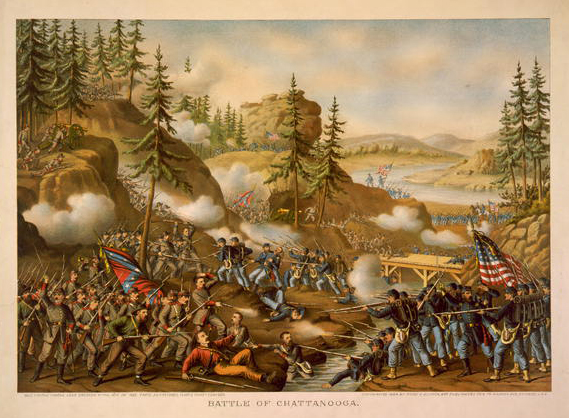By Curtis Harris

September 19th and 20th, 1863 saw the defeat of Gen. William Rosecran’s Army of the Cumberland by Gen. Braxton Bragg’s Confederate Army of Tennessee. The loss at Chickamauga forced a Union retreat into the city of Chattanooga. The Confederates quickly seized all but one supply route into the city (the Cracker Line) and threatened to force the Union force into submission by starvation.
In a meeting with John Hay on the 20th, Lincoln shows him dispatches from Rosecrans and expresses anxiety over the situation. Lincoln’s fear was well-founded as further Confederate victory could lead to the loss of central and eastern Tennessee. Seeking to gain greater control, Lincoln turned to the telegraph to deliver an instantaneous order to a general hundreds of miles away, something not possible just 10 years earlier. On the 21st he telegraphed Gen. Ambrose Burnside to “go to Rosecrans with your force, without a moments delay.”
The next day, Lincoln learns that his brother-in-law, Confederate Gen. Ben Hardin Helm, was killed in fighting around Chattanooga. The president also inquires with Rosecrans about the situation in Chattanooga on the 22nd. The news from southeast Tennessee arrives the same day and it was not good: “We are now in Chattanooga in line of battle… General Burnside will be too late to help us. We are about 30,000 brave and determined men; but our fate is in the hands of God…” Adding to this fraught situation, Burnside had made no movement to reinforce the city.
Given the increasing desperation, Lincoln on the night of the 23rd leaves his summer cottage at the Soldiers’ Home and heads to Washington City for an emergency meeting. During the session, Secretary of War Edwin Stanton proposes an audacious maneuver of men from the Army of the Potomac under Gen. Joseph Hooker to the besieged force in Tennessee via rail. Although initially hesitant, Lincoln approves the plan. 20,000 men soon began an 1100 mile, 7-day journey to reinforce Chattanooga.
With reinforcements finally arriving to the region, Lincoln takes further action by installing Ulysses Grant as head of all western armies on October 16th. Grant quickly replaced the weak-willed Rosecrans with the resolute Gen. George Thomas who declared, “I will hold the town till we starve.” On Oct. 23rd, Grant himself arrives in Chattanooga and was soon followed by Gen. William Sherman’s Army of the Tennessee. With ample soldiers and hardy commanders, the Union forces made plans for a counter-offensive.
On November 23rd, the Union armies struck Bragg’s Confederate forces. While Thomas and Hooker were making steady advances during the first two days, Sherman became ensnared on the right front. On the third day, Thomas unexpectedly achieved a total breakthrough of Confederate lines that sent them scattering southeast toward the Georgia border. Lincoln’s response to the smashing success was simple, “Your [Gen. Grant’s] dispatches as to fighting on Monday & Tuesday are here. Well Done. Many thanks to all.”
Image: Battle of Chattanooga–Gen. Thomas’ charge near Orchard Knob, Nov. 24′ 1863 (Courtesy of the Library of Congress)
